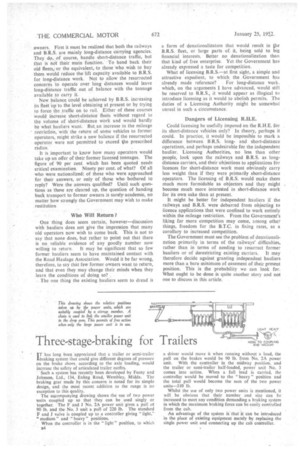Three-stage-braking for Trailers
Page 38

If you've noticed an error in this article please click here to report it so we can fix it.
IT has long been 'appreciated that a trailer or semi-trailer 'braking system that could give different degrees of pressure on the brake shoes, according to the axle loading, would increase the safety of articulated trailer outfits.
Such a system has recently been developed by Feeny and Johnson, Ltd., 134, Ealing Road, Wembley, Middx. The braking gear made by this concern is noted for its simple design, and the most recent addition to the range is no exception to this quality.
The accompanying drawing shows the use of two power 'units coupled up so that they can be used singly or together. The F and J No. 2A power unit gives a pull ot 90 lb. and the No. 3 unit a pull of 220 lb. The standard F and J valve is coupled up to a controller giving "light," "medium" and "heavy" positions.
When the controller is in the "light" position, to which a driver would move it when running without a load, the pull on the brakes would be 90 lb. from No. 2A power unit. With the controller in the midway position, and the trailer or semi-trailer half-loaded, power unit No. 3 comes into action. When a full load is carried, the controller would be moved to the " heavy " position and the total pull would become the sum of the two power units-310 lb.
Whilst the use of only two power units is mentioned, it will be obvious that their number and size can be increased to meet any condition demanding a braking system in which the maximum braking force can be easily controlled from the cab.
An advantage of the system is that it can be introduced in the place of existing equipment merely by replacing the single power unit and connecting up the cab controller_




















































































